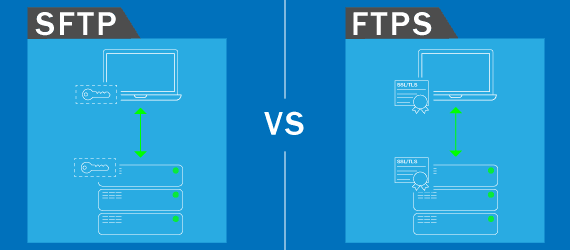Hostwinds Blog
Search results for:

SFTP vs FTPS: What's Best and Why?
by: Hostwinds Team / March 4, 2024
What is FTPS (File Transfer Protocol Secure)
FTPS, or File Transfer Protocol Secure, is a secure extension of the traditional FTP protocol. It establishes client/server connection and transmits data over SSL/TLS. TLS (Transport Layer Security) is the upgraded version of SSL (Secure Socket Layer).
What is SFTP (Secure File Transfer Protocol)
Secure File Transfer Protocol, also known as SSH File Transfer Protocol, is a file transfer protocol that uses SSH (Secure Shell) to confirm and secure the connection between client and server .
Key Differences
While both protocols are essentially performing the same actions of establishing secure client/server connections and encrypting data transmission, they are completely different protocols.
Network Communication
SFTP: Operates over a secure shell (SSH) connection for client/server authentication and encrypted data transmission.
FTPS: Utilizes SSL/TLS certificates for encryption and authentication.
Encryption and Authentication:
SFTP: Relies on SSH key pairs for authentication. SSH key pairs consist of a public key and a private key. The public key is stored on the server, while the private key is kept on the client side. During the authentication process, the client presents its private key, and the server verifies it against its public key. It can also support username/password authentication.
FTPS: Supports traditional authentication methods used in FTP, such as username/password authentication. It can also leverage SSL client certificates for authentication, which provide an extra layer of security by verifying the identity of both the client and server.
Port Usage
SFTP: Typically uses a single port, 22 by default, for both establishing the SSH connection and data transfer, simplifying firewall configurations.
FTPS: Commonly uses two ports: port 21 for establishing the connection and port 990, or other designated port, data transfer over SSL/TLS. This often requires additional firewall rules.
Ease of Implementation
SFTP: Often considered easier to implement and manage since it uses SSH, which is widely supported and integrated into many operating systems and software applications. Also, the use of a single port makes firewall configuration more straightforward.
FTPS: May require more configuration and management efforts, especially when dealing with SSL/TLS certificates and port configurations. SSL/TLS certificate deployment and renewal can be costly and time consuming. Multiple port management opens the risk of firewall misconfiguration.
Firewall Configuration
SFTP: Uses a single port for both control and data transfer, simplifying firewall configurations and is more firewall-friendly in restrictive network environments.
FTPS: Uses separate ports for control and data transfer, which requires additional firewall rules, potentially complicating network setup.
Commands
SFTP: Allows for precise control over file and directory permissions, enabling administrators to define access rights at a granular level for individual users or groups.
FTPS: Commands are much more basic. Users can access and retrieve files from the server but are unable to manipulate or change ownership of them.
SFTP vs FTPS - Which One is Better?
SFTP and FTPS are both popular and secure protocols for transferring files between networks.
On the face of it, SFTP is superior to FTPS due to its end-to-end security and full encryption, ease of implementation, and more freedom with commands.
But that's not to say FTPS shouldn't be considered. Since it's an extension of FTP it is widely supported by FTP client and server software, is backwards compatible with existing FTP infrastructure, and has a bit more flexibility in the realm of authentication methods.
Overall, the choice between SFTP and FTPS depends on factors such as security requirements, ease of implementation, and compatibility with existing systems. SFTP may be preferred for its strong security features and ease of management, while FTPS may be chosen for its compatibility with legacy systems and flexible authentication options.
After reading this, look at your needs, look at what you're currently working with and you should be able to make an informed decision.
Written by Hostwinds Team / March 4, 2024
